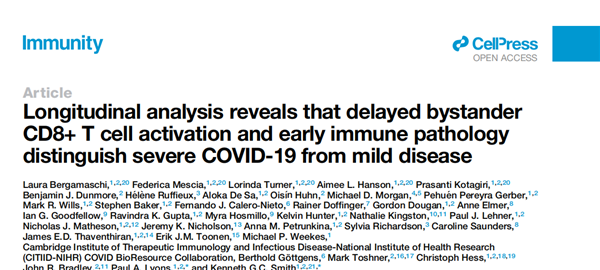《Longitudinal analysis reveals that delayed bystander CD8+ T cell activation and early immune pathology distinguish severe COVID-19 from mild disease》由 Laura Bergamaschi 等人撰写。文章通过对 COVID-19 患者的纵向分析,揭示了严重和轻度疾病在免疫反应上的差异,为深入理解 COVID-19 的免疫病理机制提供了重要依据。

研究团队通过对COVID-19患者的一系列样本进行免疫表型分析、RNA测序和血清细胞因子分析,分析了207名SARS-CoV-2感染者的免疫反应,这些感染者的疾病严重程度不同,研究时间跨度为症状出现后的12周。研究发现,轻症或无症状患者的早期免疫反应特征是强烈的旁观者CD8+ T细胞免疫反应,而不伴有系统性炎症。相比之下,住院患者的旁观者反应延迟,且在症状出现时就已显示出系统性炎症,这表明某些个体中免疫病理可能是不可避免的。
研究意义
这项研究的意义在于,它提供了对COVID-19免疫病理机制的深入理解,特别是在轻症与重症之间的差异。这些发现可能有助于开发新的治疗策略,特别是那些针对早期免疫反应和炎症途径的干预措施。通过了解补体系统在疾病中的作用,医生和研究人员可以更好地预测疾病进展,并为患者提供更个性化的治疗方案。HK328试剂盒作为测量补体系统激活状态的工具,在这一研究中发挥了重要作用,为理解COVID-19的免疫反应提供了重要数据。
终末补体复合物(TCC)ELISA 试剂盒,货号:HK328,在研究中的作用和价值
终末补体复合物(TCC),也称为sC5b-9,是评估人体免疫反应的重要生物标志物。该复合物在研究工作中至关重要,是机体先天防御机制的核心。HK328试剂盒在本研究中的作用是测量COVID-19患者血清中的TCC水平,这有助于研究人员评估补体系统在疾病中的作用。补体系统的激活与炎症反应密切相关,因此,通过HK328试剂盒测量TCC水平,研究人员可以:
1、评估炎症程度:TCC水平的升高可能表明补体系统被激活,从而反映了体内炎症反应的强度。
2、监测疾病进展:通过比较不同时间点的TCC水平,研究人员可以监测疾病的进展和患者的免疫状态变化。
3、理解免疫病理机制:TCC水平的变化可能揭示补体系统在COVID-19免疫病理中的具体作用,有助于开发新的治疗策略。
在实验中,HK328试剂盒提供了一种可靠和标准化的方法来测量TCC,这对于理解COVID-19的免疫反应至关重要。通过这种定量分析,研究人员能够更准确地评估补体系统在轻症与重症COVID-19中的不同作用,为疾病的诊断和治疗提供了重要信息。
产品详情:TCC ELISA, human, kit,货号:HK328
| 产品名称 | 终末补体复合物(TCC)ELISA 试剂盒 TCC(SC5b-9) ELISA human kit |
| 货号 | HK328 |
| 规格 | 1x96,2x96 |
| 标准范围 | 8.2至2000 mAU/ml |
| 检测水平 | 8.2 mAU/ml |
| 工作体积 | 100 μl/孔 |
| 物种 | 人类 |
| 交叉反应性 | 食蟹猴-是,马-否,小鼠-否,猪-是,兔-是,大鼠-否 |
| 储存和稳定性 | 产品应储存在4°C。在推荐的储存条件下,产品至少稳定六个月。 |
| 说明书 |
* 【相关推荐】 TCC单克隆抗体,推荐:TCC, Human, mAb aE11,货号HM2167
原理:
人类TCC ELISA是一种即用型固相酶联免疫吸附测定,基于夹心原理,工作时间为3?小时。两块板的高效格式配有十二个一次性8孔条带,允许自由选择检测批次的大小。样本和标准通过固相结合的特异性抗体进行捕获。生物素标记的追踪抗体将结合到捕获的TCC上。链霉亲和素-过氧化物酶复合物将结合到生物素标记的追踪抗体上。链霉亲和素-过氧化物酶复合物将与底物四甲基联苯胺(TMB)反应。通过加入草酸来终止酶反应。在450 nm处用分光光度计测量吸光度。通过绘制吸光度(线性)与相应的TCC标准浓度(对数)的关系获得标准曲线。样本的TCC浓度可以通过与标准同时进行的标准曲线来确定。
发表文章:
Activation of final complement components after kidney transplantation as a marker of delayed graft function severity
Alginate microbeads are coagulation compatible, while alginate microcapsules activate coagulation secondary to complement or directly through FXII
Arginine Catabolic Mobile Element Is Associated With Low Antibiotic Resistance and Low Pathogenicity in Staphylococcus epidermidis From Neonates
ATYPICAL HEMOLYTIC UREMIC SYNDROME AND GENETIC ABERRATIONS IN THE COMPLEMENT FACTOR H RELATED 5 GENE
Common complement factor H polymorphisms are linked with periodontitis in elderly patients.
Complement activation in severely ill patients with sepsis: no relationship with inflammation and disease severity
Complement Activation in the Disease Course of Coronavirus Disease 2019 and Its Effects on Clinical Outcomes.
Complement activation on platelet-leukocyte complexes and microparticles in enterohemorrhagic Escherichia coli-induced hemolytic uremic syndrome.
Complement as Prognostic Biomarker and Potential Therapeutic Target in Renal Cell Carcinoma.
Complement C3 inhibition in severe COVID-19 using compstatin AMY-101
Complement C3 inhibitor Cp40 attenuates xenoreactions in pig hearts perfused with human blood
Complement Inhibition in a Xenogeneic Model of Interactions Between Human Whole Blood and Porcine Endothelium
Delayed bystander CD8 T cell activation, early immune pathology and persistent dysregulation characterise severe COVID-19
Effect of long-term remote ischemic conditioning on inflammation and cardiac remodeling.
In vitro hemo- and cytocompatibility of bacterial nanocelluose small diameter vascular grafts: Impact of fabrication and surface characteristics.
Increased activation product of complement 4 protein in plasma of individuals with schizophrenia
Internalization of the Membrane Attack Complex Triggers NLRP3 Inflammasome Activation and IL-1β Secretion in Human Macrophages
Liposomal Composition Based on Hydroxyaluminum Phthalocyanine and Gold Nanoparticles for Combined Photodynamic and Photothermal Therapy
Longitudinal analysis reveals that delayed bystander CD8+ T cell activation and early immune pathology distinguish severe COVID-19 from mild disease
Manipulation of Serum Protein Adsorption by Nanoengineered Biomaterials Influences Subsequent Immune Responses.
Modulating acrylic acid content of nanogels for drug delivery & biocompatibility studies.
Pitfalls in complement analysis: A systematic literature review of assessing complement activation
Proinflammatory cytokines driving cardiotoxicity in COVID-19
Quiescent complement in nonhuman primates during E coli Shiga toxin-induced hemolytic uremic syndrome and thrombotic microangiopathy
Selected CSF biomarkers indicate no evidence of early neuroinflammation in Huntington disease
Serological and genetic complement alterations in infection-induced and complement-mediated hemolytic uremic syndrome
sMR and PTX3 levels associate with COVID-19 outcome and survival but not with Long COVID
Staphylococcus epidermidis polysaccharide intercellular adhesin activates complement
Structural characterization and immunomodulating assessment of ultra-purified water extracted fucoidans from Saccharina latissima, Alaria esculenta and Laminaria hyperborea
Structural Characterization of Fucoidan from Laminaria hyperborea : Assessment of Coagulation and Inflammatory Properties and Their Structure-Function Relationship.
Submicron-Sized Nanocomposite Magnetic-Sensitive Carriers: Controllable Organ Distribution and Biological Effects
Sulfated alginate microspheres associate with factor H and dampen the inflammatory cytokine response.
Systemic complement profiling in multiple sclerosis as a biomarker of disease state
The role of complement and extracellular vesicles in the development of pulmonary embolism in severe COVID-19 cases



 经营性网站备案信息
经营性网站备案信息 鄂公网安备42018502007175
鄂公网安备42018502007175